
Contents
When we think of wine, the country we first think of is usually France. But is the wine of French origin? Which country was the first to discover wine?
The first steps
Mesopotamia
The history of wine began over 8,000 years ago. The first vines were grown in Mesopotamia, the cradle of civilization and agriculture. The Egyptians, pioneers of agriculture, mastered the art of growing vines.
Thanks to archaeological digs and the discovery of wine jars, we know that they were already drinking wine. At the time, it was a drink reserved for sovereigns and their entourage. Wine wasn’t exactly a beverage in its own right: honey, fruit and cereals were added to it… Nevertheless, it was the Egyptians who invented the notions of crus, vintages and “cellar masters”, and who taught the Greeks how to cultivate vines.
Ancient Greece
Between 2000 and 500 B.C., vines had become an essential part of Greek agriculture. then exported it throughout the Mediterranean basin, notably to Italy, Sicily and North Africa, then to Spain, Portugal and Gaul. Herbs and spices were added to the wine and it was cut with water.
The god Dionysus becomes emblematic of wine and the pleasures and excesses that accompany it. Later, the Romans took over, producing wine in astronomical quantities…and associating it with their own god, Bacchus.
The Roman Empire
From 125 BC onwards, the Romans spread the vine to the rest of Europe. In Rome, everyone drank wine: noble families as well as the lower classes and slaves. Wine is served at banquets and acquires a certain prestige.
The Romans used plaster, fenugreek and sea water for winemaking. The role of the plaster was to increase the acidity of the wine and give it brilliance. However, it was known to act on the nerves and cause headaches.
While the barbarians consumed wine neat, the Romans diluted it with water, because that’s what was considered civilized.
Wine as we know it first appeared in the Middle Ages
With the fall of the Roman Empire, the Church took control of vine cultivation and the wine trade. Winemaking processes were theorized, and the monks perfected vine cultivation by studying soil, climate and sun exposure. The abbeys of Burgundy thus became renowned for the quality of their production.
Wine is consumed neat and is preferred to water, which carries microbes and bacteria.
Later, colonization brought wine to all parts of the world, particularly Latin America and the United States.
Recent history
Pasteur is known as the father of oenology thanks to his studies of alcoholic fermentation.e century, wine became a real science, combining chemistry, biology and physics.
In addition, vineyards have been hierarchized since 1935, with the invention of the AOP indication, the result of numerous frauds following the destruction of a large part of the French vineyards by phylloxera and the chaos left by the First World War.
Today, wine studies continue, geographical indications are multiplying…and we still have a lot to learn!




